Table of Contents
Follow these well-researched and time-tested tactics for increasing your SaaS upsell. Then, continue reading for more information on how to develop cross-selling and upselling tactics.
When you are building a relationship with a consumer, there will come the point when your customer is ready for something more from your company. A clear indicator that your product is bringing sufficient value to the customer’s operations. And when it achieves its maximum potential, it becomes essential for both parties to expand their respective businesses. As a result, an upsell will inevitably occur in such a circumstance.
Generally speaking, upselling is urging customers to purchase a higher-level version of a more expensive product than the one they are now using. Thus, according to the seller’s point of view, the term “upsell” has a more appropriate connotation.
However, in actuality, it is a transaction in which both parties, the buyer and the seller, are equally invested. You don’t simply offer your higher-version goods to make more money; you also sell them to help others. That high-end product should also be able to provide sufficient value to the buyer. Only in this case can such transactions be considered a win-win situation for both parties involved.
Why should you upsell?
Apart from the most apparent advantage of an upsell to the business, which is an increase in income, companies are several other reasons to consider using SaaS upsells.
For Business
- Increased Return on Investment (ROI): Every firm must spend money to acquire new customers at first. With the hope of recouping the costs in the future by further development, they pay the prices now. They can boost their return on investment through the use of upsells.
- Increase in customer lifetime value: One of the most sought-after indicators in the SaaS customer success industry. Companies anticipate that every consumer will remain with them for a lengthy period and spend more money. Upselling is an excellent method of accomplishing this aim.
- Enhances client loyalty: When customers are exposed to more items, and a broader range of services offered by a company, a more intimate relationship is developed between the two parties. In addition, Upsells allows you to provide extra touchpoints and hooks to consumers, encouraging them to immerse themselves further in your product experience.
For Clients
- Greater experience: A higher-version product is by definition more sophisticated in terms of performance and features and having more of them. This enables the client to benefit from their previous experience with the product in question.
- Business requirements: Clients are often unaware of the additional needs in their business operations until a CSM directs them towards more complex features and functions. When they improve, they will be able to accomplish far more than they previously believed was possible.
- Better service: It is usually preferable for the client to develop their business with a firm already familiar with them. They will receive tailored service due to the customer success upsell offered by the present provider. This is significantly preferable to purchasing a new product from a different firm, in which case the customer experience would have to be restarted from the very beginning.
Upsell vs. Cross-sell
The terms upsell and cross-sell sometimes used interchangeably; nevertheless, they are not the same thing. The term “upsell” refers to the process of upgrading a product to include more sophisticated features.
On the other hand, Cross-selling is primarily about offering distinct but related items that might help consumers get more out of their current user experience.
It is more like recommending that they acquire more things and the primary product they have already purchased. Upsells correspond to the depth of the product, while cross-sells correspond to the width of the product.
Upselling Strategies For SaaS Companies
As a customer success manager, you must constantly maintain the client’s best interests at the forefront of your thinking. In your organization, you are the first point of contact with the consumer.
Furthermore, the upselling transactions you get into with them should always align with what they truly require for their company.
You must use extreme caution to ensure that your customer does not receive the incorrect impression of mis-selling. The most effective methods of executing upsells are explained further below.
Track usage limits
The most effective upsell approach is to track the customer’s usage limitations and offer them more services. You are already aware of the highest point that a consumer may achieve when utilizing your essential service or product.
There is no purpose in pursuing them for further business until they have already reached that limit.
As a result, you must wait until they have reached their use limit with the current plan before suggesting that they upgrade to a more expensive plan or version.
Display in-app upsell possibilities
Another method of determining whether or not a consumer is ready for an upsell is to use in-app features.
This allows you to demonstrate the advanced functionality inside the context of the primary offering. The only difference would be that they would not function unless the consumer decided to purchase the more expensive version.
This will allow you to make them aware of upselling chances without having to approach them directly.
Users would know when it was the right moment to purchase it after a significant amount of time spent hitting those restricted features. Additionally, the entire purchase process may be automated by using a link that they must click on from within the app to complete the transaction.
Collaborate with other teams
A customer success upsells the result of a collaborative effort. Therefore, your consumer may interact with your firm on several occasions over their relationship with you.
It would help if you took advantage of these contacts to build the best possible upsell offer that is difficult to refuse. For example, approaching a client while they have an open support ticket for any issue would not be the most significant moment to upsell them.
Furthermore, when your product team delivers a new version, you may communicate with customers who have already expressed an interest in the features that are included in the latest release.
Use customer health score
Your customer success platform’s north star statistic is the health score of each client. You would be able to identify the client accounts that are the most loyal and happy with your product in this way.
All required is to utilize the customer health score to identify the best performers and make upselling recommendations.
Customers who are most loyal and satisfied are more inclined to evaluate any new offers you present to them. Moreover, if your product is beneficial to them, selling them will be a lot easier to do.
Utilize social proof to pursue and persuade the upsell opportunity
There are several approaches you can take to use social proof to convince your clients to purchase an upsell that will help their company.
When determining how many consumers will use an add-on product in addition to a regular purchase, for example, make sure you have this information available to communicate with your customers so that they can make an informed decision.
Is it possible that your organization has received a recent customer review for this same offering? Then, perfect, show this to your customer so that they may understand firsthand what your consumers are going through.
Customers who want more than just evaluations may occasionally approach you, and you may be able to provide them with more information. The most effective strategy you can use in this situation is to introduce a chosen list of your current customers who are satisfied with the item you are pitching to a new customer.
Again, this will need a little more work on your part because you will need to email your current customers and obtain their permission to refer them to the consumer who is presently reviewing your service.
However, given that social proof is a compelling aspect, this is also an option to consider. Don’t be afraid to implement any efforts that will assist your clients in building trust in your goods.
Timing Is everything
It’s possible that you’re thinking to yourself, “Okay, now that I have the list of consumers I want to target for upselling, what’s next?” So, let me tell you what comes next: making preparations for possible upsell chances. One of the most important aspects of any upselling strategy is the use of appropriate timing.
Once you’ve compiled a list of clients with whom you’d like to explore upsell opportunities, you’ll need to ensure that each customer is progressing along the correct path in their customer journey. We want to ensure that upsells coincide with key customer journey milestones, such as onboarding and renewal, by considering the primary customer journeys.
You wouldn’t want to overload a client who is just getting started with your product and hasn’t seen any success or any projects come to completion; therefore, now is not the most significant moment for you to try to upsell them.
As soon as a successful effort or a significant milestone (e.g., meeting a new lead generation target) has been completed, use the opportunity to stand back and ask your consumers, “What’s next?”
It is possible that your consumers will not be forthcoming with information about the milestones they have reached while using your product. Therefore, before embarking on the customer journey, it is critical to establish and track quantifiable objectives for your customers’ current service level agreement.
There is no question that unless you have demonstrated that your product can generate concrete outcomes for their business, no one will spend extra resources on purchasing additional products from your organization. As a result, the sooner you achieve success, the sooner you may initiate these upsell talks.
Be transparent before the renewal
A little tough, and it might not apply to every single one of your consumers. For example, small and medium-sized firms (SMEs) mostly use finance to analyze and sign off on contracts. The medium to enterprise-level clients, on the other hand, may have a procurement team that reviews all of the agreements that come in through various departments. So, what does this mean for you and your situation?
If your client isn’t taking advantage of your product to its full potential, don’t be afraid to approach procurement and ask if they know of other departments or teams that may benefit from your services. In addition, because they are reviewing many contracts, they may determine what other organizations are utilizing to solve specific business challenges.
Remember that the finance and procurement teams are primarily concerned with ensuring that their organization receives the most value for its money. You can use an upselling script like this: “Do you happen to know if there are any teams at XYZ company who would benefit from using the XYZ product offering you currently have access to?” or “Do you happen to know if there are any teams at XYZ company who would benefit from using the XYZ product offering you currently have access to?”
To assist them in saving more money, you should ask about these questions to gain more insight into the potential upsell chances that may be available.
Saas Upselling Examples
You must have a well-positioned, well-designed upgrade or upsell prompt in place for consumers to convert from a free trial to a paid plan or for loyal customers to be upgraded to a higher tier. The key is to make it as appealing and straightforward as possible for customers to upgrade—without assaulting them with regular ads telling them they must pay up or face dire consequences.
We’ll go through some instances of businesses that are very good at upselling in the next section.
Spotify
The likelihood that your consumers will visit your pricing page to learn about higher-tier features is low unless they are actively considering upgrading (and how often does that occur?). Therefore, customers should be made aware of premium features rather than expected to seek them out independently. This may be accomplished by placing reminders inside the user interface itself.
Take, for example, the streaming service Spotify. Users of free Spotify accounts are only permitted to skip six tracks per hour before being encouraged to subscribe to a premium subscription. The premium function is seamlessly incorporated into the user experience, allowing users to see it in action and understand how it might benefit them.
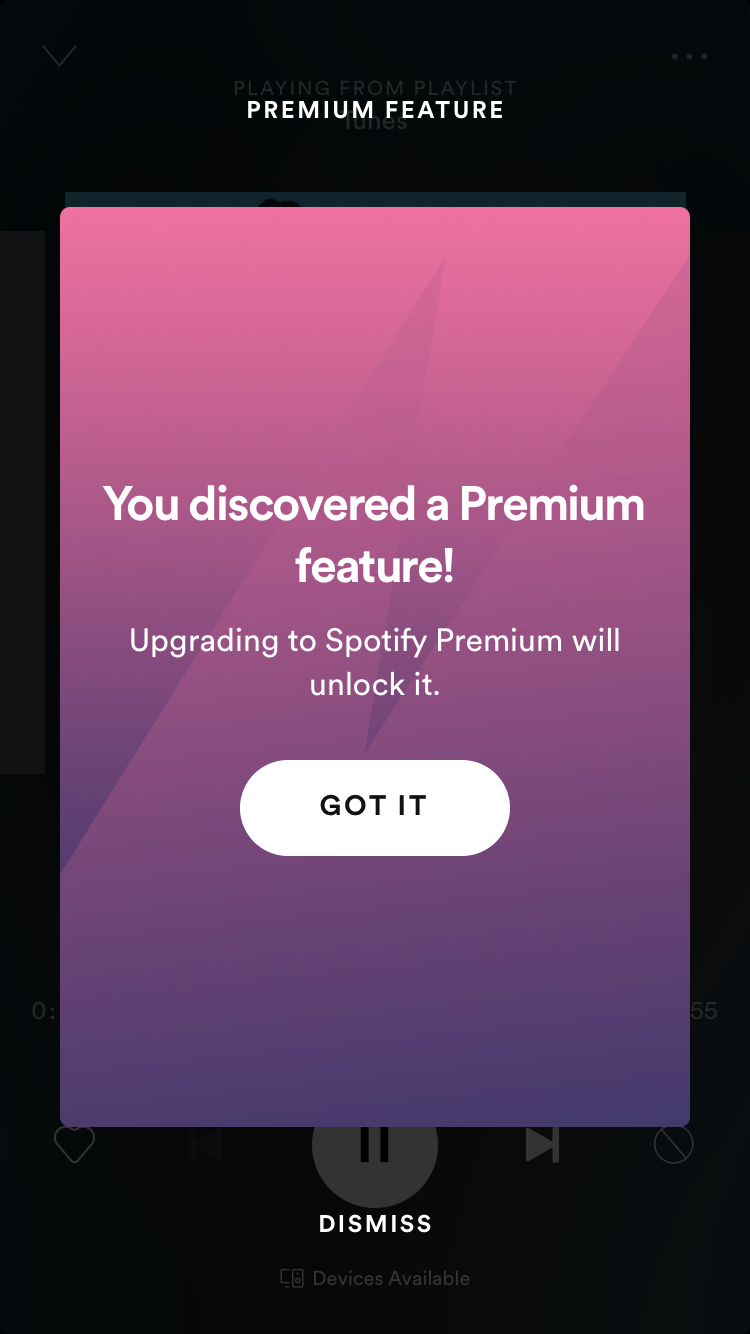
Furthermore, Spotify has ingeniously positioned this upsell suggestion as a time of discovery for the listener. “You found a Premium feature,” as opposed to “you are not permitted to do it unless you pay us,” has a far more positive ring to it.
Airtable
While it comes to communicating with your users, in-app messaging is one of the most efficient and relevant methods available—but by its very nature, in-app messaging is only successful when users are, well, in your app. MSo takes use of the opportunities you have to interact with your customers outside of your product.
Users who are not currently using your product can be reached by sending them an intriguing engagement email with their in-product upgrade prompts. Would you please make use of your newsletter to provide readers with the opportunity to browse features without overwhelming their inbox with an additional email send?
The Airtable newsletters do an incredible job of covering all of this ground. The information contained in this upsell email is much more than a mere cash grab; it also lays down some of Airtable’s premium features and advice to help you get the most out of them.
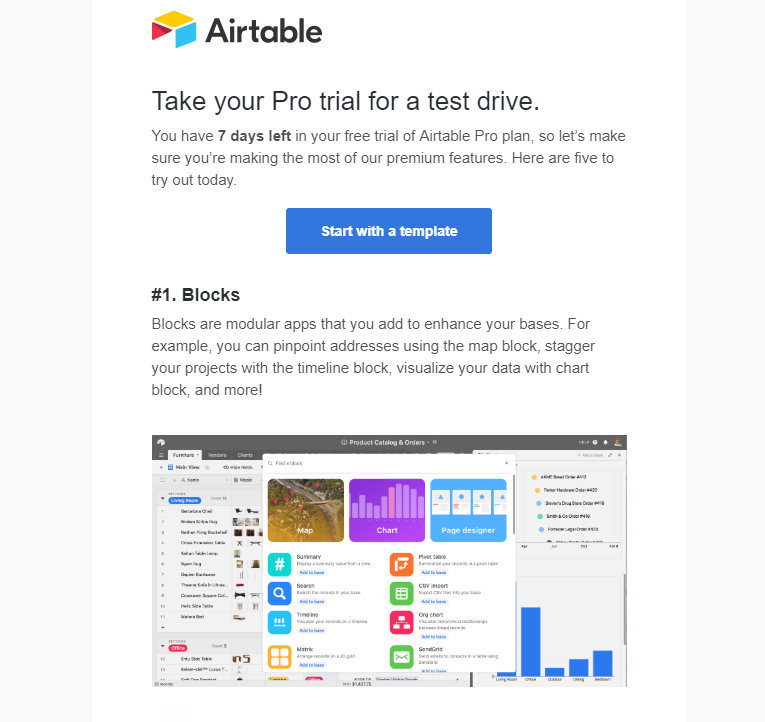
Squarespace
Integrations help to extend the useful life of your software. While a user may not be interested in leveling up in your app at this time, they may be highly interested in utilizing your product in conjunction with another in their tech stack in the future. As a result, the more a user invests in your development and incorporates it into their daily routine, the more probable it is that they will continue to use it in the long run – and eventually, upgrade. The integration of your app with other products in their tech stack will not only make your app more helpful and valuable to the job they perform, but it will also make your app necessary to them.
To maximize upselling prospects, set aside some integrations for higher-tier plans and demonstrate to other users what they’re losing out on.
Squarespace’s commerce connectors, for example, are only available as premium features in the Commerce Advanced plan, which is only available to those who have purchased the program. Instead of aggressively encouraging you to upgrade, it takes a more gentle approach to upselling and allows you to understand more about why you might require one of these plans.
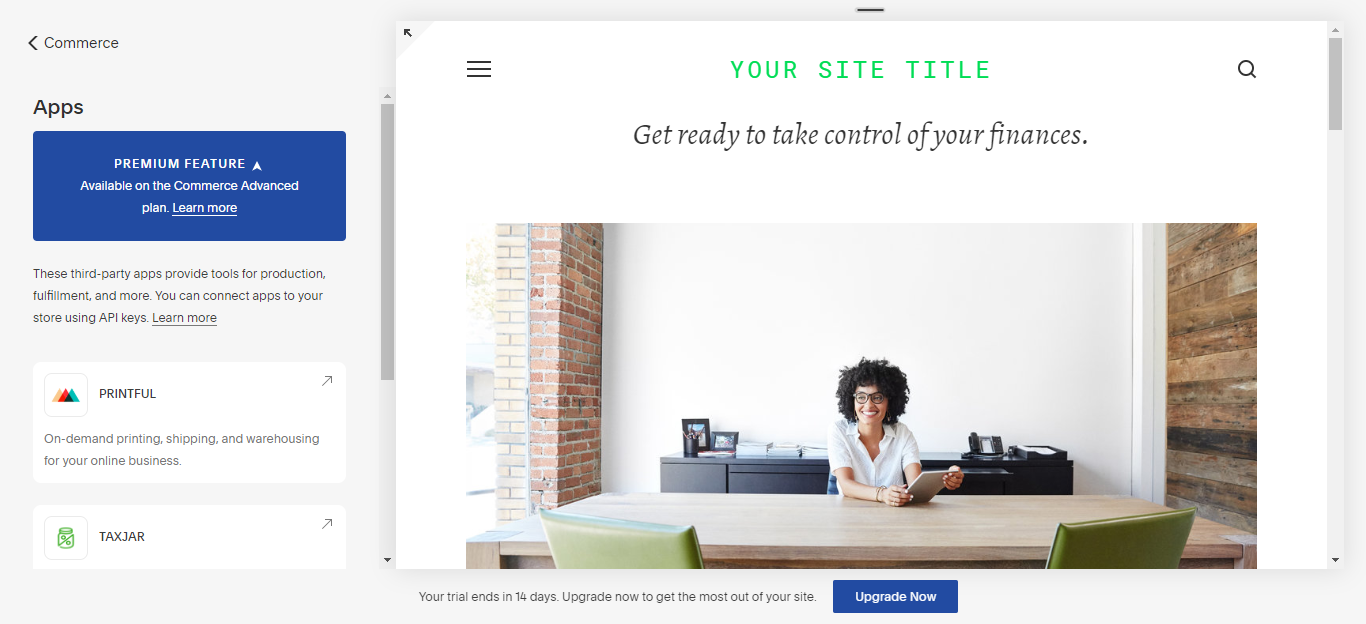
Customers that utilize your integrations will be inspired to do more important and better things with your product. Ration and celebrate those features to turn them into upselling chances.
Zapier
Upgrade your system. If you utilize your CTA too aggressively when users have just arrived in your app—or are attempting to use the capabilities of their existing plan—you run the risk of irritating them rather than engaging them. As an alternative, you should link your upgrade prompts to specific user activities to assist consumers in recognizing their own needs for your premium services.
For example, when users click on a higher-tier function, Zapier opens a modal box that provides them with a single button to upgrade. There is no room for misunderstanding in this scenario, and the directness is booming since the alert appears while users are already driven to perform the task at hand. Using active involvement as a springboard for your upgrade prompt is an excellent method to contextualize your upgrade prompt while taking advantage of user-driven momentum.
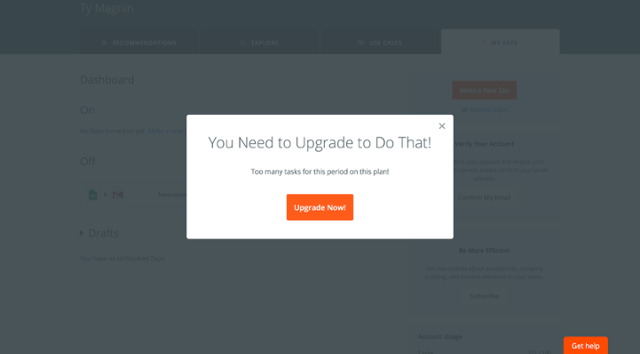
Harvest
Suppose you don’t want to wait until customers click on a feature to inform them that it is premium. In that case, you may include premium features alongside regularly used free elements to grab the user’s attention and entice them to learn more.
In this example, harvest hides its premium features—the “import” option, which is greyed out—but retains the call-to-action (CTA) prominently displayed between two other free-to-use buttons. In addition, when you hover your cursor over the import functionality, a tooltip with an inline upgrade link appears.
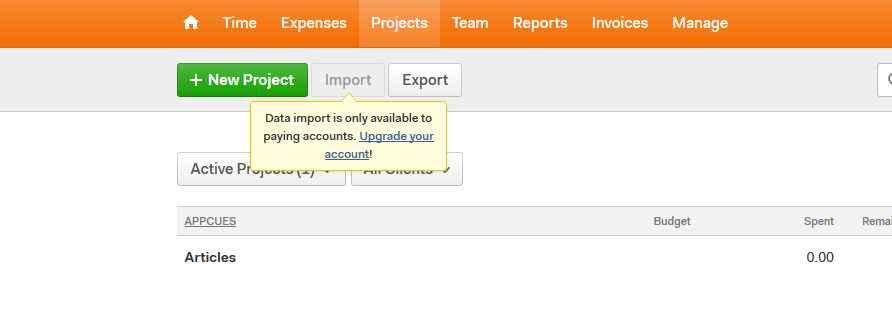
Dropbox
You don’t have to wait until consumers have used up all of the features in their current plan before prompting them to upgrade to a higher-level program.
Customers are reminded of the limitations of the free plan frequently through continuous upsell prompts, which also allow them to upgrade at any time. The fact that these prompts are ever-present (but easily dismissed) allows Dropbox to cleverly switch up the content, which gently captures attention from customers who may otherwise have tuned out the repeated promptly.
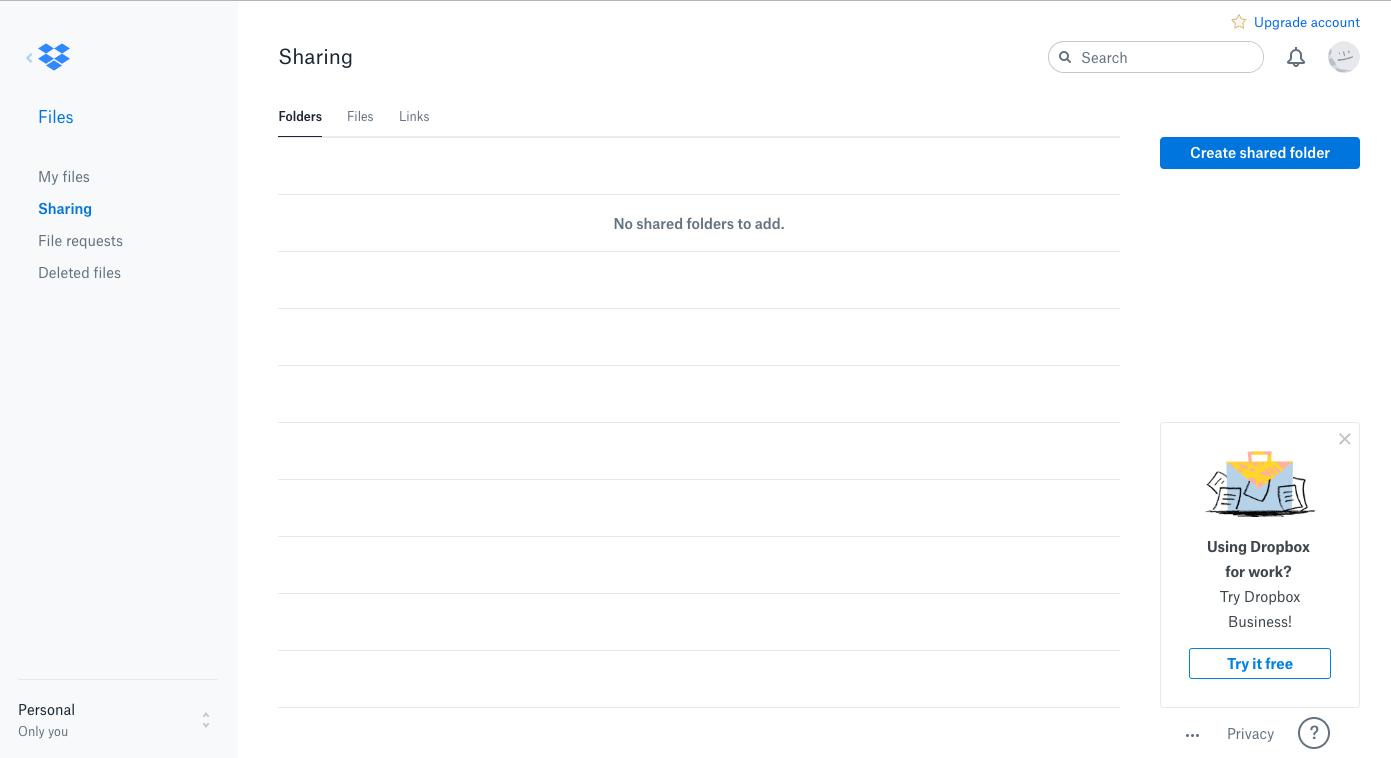
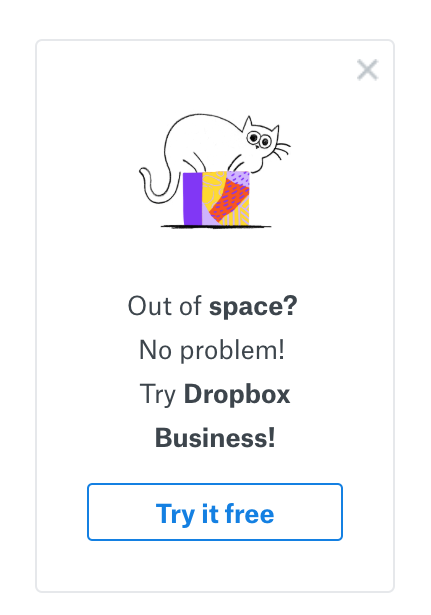
In addition, these sideline suggestions aren’t the only way to get people to take action. For example, customers who use the product regularly are reminded that they might be getting more out of it if they upgrade to a premium account in a subtle but convincing way.
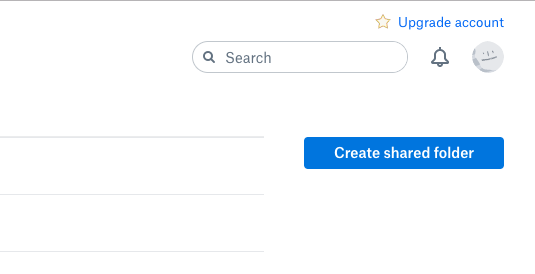
15Five
Customers should be reminded of the advantages of purchasing the more expensive deluxe edition of your goods. One of the most effective methods of accomplishing this is by including discrete upsell prompts into their usual routines. Providing you keep the user experience in mind and avoid taking a heavy-handed approach, these sorts of prompts can serve as helpful reminders about the benefits of upgrading to a higher price tier.
15Five employs this strategy to significant effect by including upsell messaging into the routine workflow of managers and supervisors. Management is prompted with hotspots while examining reports inside the 15Five web interface, emphasizing upgrading to one of the higher-level plans. For example:
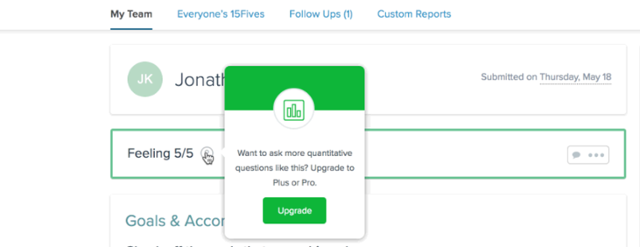
The product also pushes premium features on the app’s main menu, accessible from the home screen. Management is presented with a complete page of features that persuade them to upgrade their plan when selecting the “Objectives” tab. These features include:
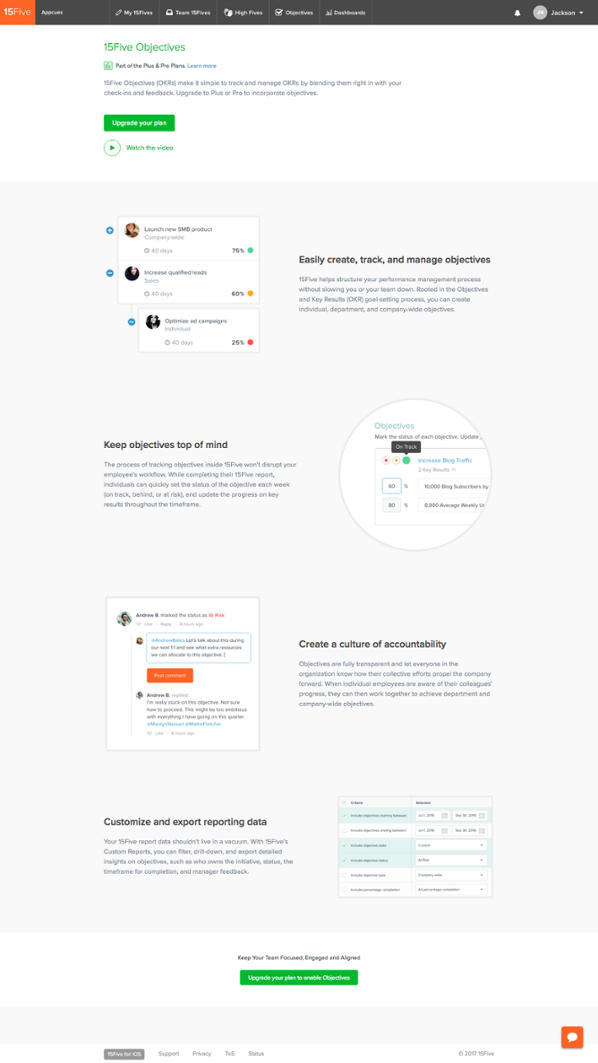
Asana
Although many businesses concentrate their upselling efforts on consumers on a free or freemium plan, companies should also consider increasing income by converting paying customers to more premium pricing plans.
Power customers who currently pay for your product will be more likely to upgrade if you first discover the additions that bring the most extra value to each cohort. It’s critical to understand how your customers’ requirements will vary as they progress up the organizational hierarchy—for example, what distinguishes individuals or small enterprises from corporate users.
As an example, the project management platform Asana restricts access to its Portfolios and Workload features, the value of which may not be immediately apparent to new users but which becomes increasingly valuable as you increase your reliance on the program.
The dashboard is replaced with a film that explains how Portfolios and Workload operate and an upgrade CTA when free or mid-tier customers select the option.
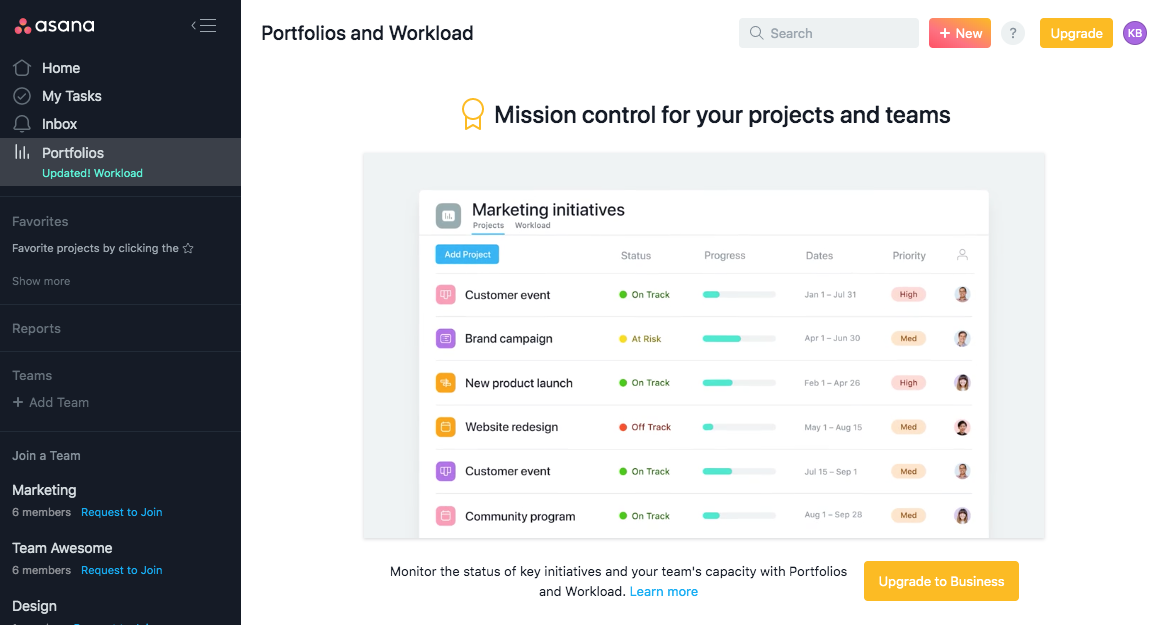
Slack
When your pricing is arranged around the most critical value measure, it is easy to persuade people to upgrade their accounts.
Slack is well-known for employing this strategy to fuel its meteoric rise to prominence. On its free plan, Slack restricts enterprises to a maximum of 10,000 stored messages. If these businesses want access to their whole history, they will need to subscribe to a premium subscription.

The company does not put up a rigid barrier but instead indicates that consumers may be obtaining additional value from using the service.
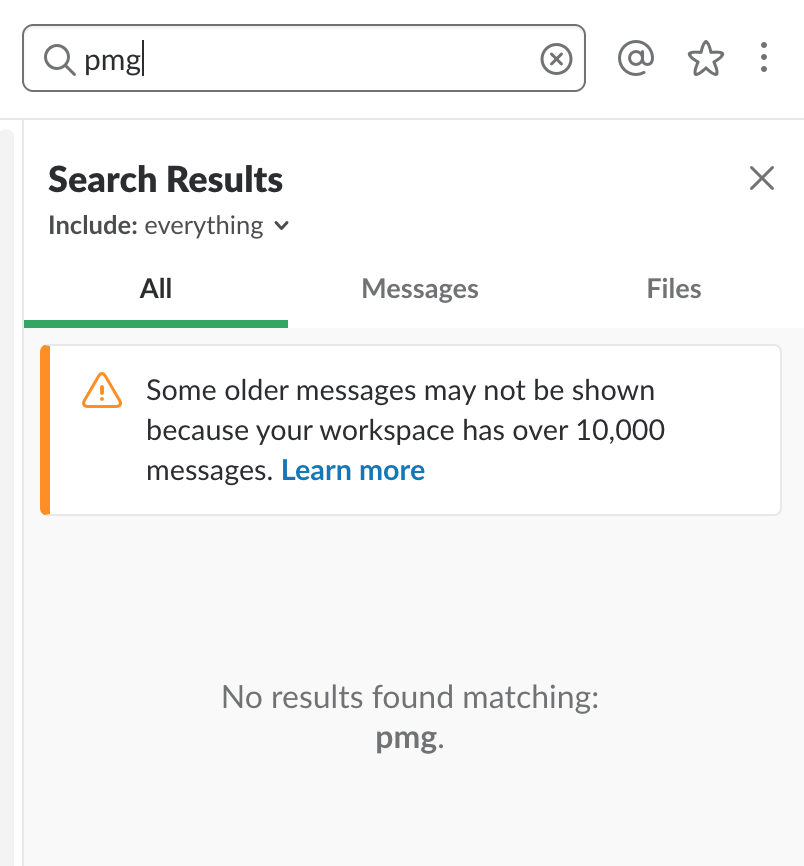
An understated freemium upgrade prompt is intended for people who desperately need a particular feature.
Final Thoughts
Developing a long-term relationship with your consumer is the result of your efforts to upsell to them. The quickest and most effective method to destroy a client connection is to treat them as a number.
However essential you believe upselling to be, the retention of your customers will always take precedence over all other factors. Therefore, do not approach them until you have prepared for them without offering them a contextual answer relevant to their situation.
